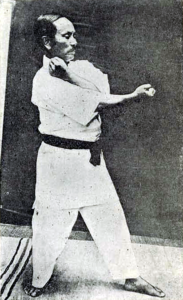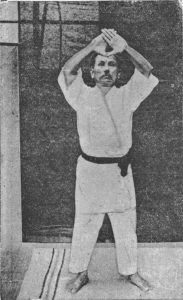Kata has always been an integral part of any Karate practice. In Shōtōkan Karate, Kata is a sequence of pre-arranged movements. The basic goal of Kata is to preserve and transmit proven techniques and to practice self-defence. By practicing in a repetitive manner the learner develops the ability to execute those techniques and movements in a natural, reflex-like manner.
Funakoshi transformed Okinawan Karate into a Japanese art by infusing it with concepts taken from Japanese budō (literally, martial ways). Funakoshi further changed the names of the kata for reasons of his own and he recognised karate terms in conformity with kendo, Japanese Fencing.
| Kata Name | Kanji | Meaning | Kata Groups |
|---|---|---|---|
| Taikyoku Sho-dan | 太極初段 | First cause - first level | Modern |
| Taikyoku San-dan | 太極初段 | First cause - second level | Modern |
| Heian Sho-dan | 平安初段 | Peaceful mind - first level | Heian |
| Heian Ni-dan | 平安二段 | Peaceful mind - second level | Heian |
| Heian San-dan | 平安三段 | Peaceful mind - third level | Heian |
| Heian Yon-dan | 平安四段 | Peaceful mind - fourth level | Heian |
| Heian Go-dan | 平安五段 | Peaceful mind - fifth level | Heian |
| Tekki Sho-dan | 鉄騎初段 | Iron horse - first level | Tekki |
| Tekki Ni-dan | 鉄騎二段 | Iron horse - second level | Tekki |
| Tekki San-dan | 鉄騎三段 | Iron horse - third level | Tekki |
| Bassai-Dai | 披塞大 | To penetrate the fortress - big | Sentei |
| Kanku-Dai | 観空大 | To look at the sky - big | Sentei |
| Jion | 慈恩 | Named after the Temple Jion-Ji | Sentei |
| Empi | 燕飛 | Flying swallow | Sentei |
| Jitte | 十手 | Ten hands | Advanced (Funakoshi) |
| Gankaku | 岩鶴 | Crane on a rock | Advanced (Funakoshi) |
| Hangetsu | 半月 | Half moon | Advanced (Funakoshi) |
| Kanku-Sho | 観空小 | To look at the sky - small | Advanced (Nakayama) |
| Bassai-Sho | 披塞小 | To penetrate the fortress - small | Advanced (Nakayama) |
| Chinte | 珍手 | Incredible hands | Advanced (Nakayama) |
| Nijushiho | 二十四步 | 24 Steps | Advanced (Nakayama) |
| Sochin | 壯鎭 | Preserve peace | Advanced (Nakayama) |
| Unsu | 雲手 | Hand of a cloud | Advanced (Nakayama) |
| Gojushiho-Sho | 五十四歩小 | 54 Steps - small | Advanced (Nakayama) |
| Gojushiho-Dai | 五十四歩大 | 54 Steps - big | Advanced (Nakayama) |
| Meikyo | 明鏡 | Mirror of the soul | Advanced (Nakayama) |
| Wankan | 王冠 | Crown of a king | Advanced (Rare) |
| Jiin | 慈陰 | Named after the Temple Jion-Ji or the saint | Advanced (Rare) |
Kata Groups
Kata Groups
These modern kata were created in the 30's by Gichin Funakoshi and his son Gigo. They are the most basic kata, feeling more like kihon. They were made to simplify the teaching of karate to large groups of students. By today's standards they are considered overly simplified and most instructors view them as obsolete. However, although these kata do not form part of the 25 kata of JKA Shōtōkan karate, Taikyoku Shodan is a required kata for early kyu exams at several dojo, including the honbu dojo in Japan (as listed on the JKA website).
The five Heian kata (or Pinan in Okinawan) were developed by Gichin Funakoshi's teacher, Yasutsune Itosu, to facilitate the teaching of karate to large groups of students. The word Heian is a combination of the word heiwa, meaning "calm" or "peaceful," and the word antei, which means "easy" or "stable." Therefore, Heian could be translated as "Peace and Stability." Gichin Funakoshi uses the translation "Peaceful Mind" in his book Karate-Do Kyohan. Heian kata are taught to beginner and intermediate students. It is through practice of the Heian kata that the student learns the basic skills of karate.
It should be noted that, originally, Heian Shodan and Heian Nidan were taught in reverse order, with names reversed as well. Gichin Funakoshi switched their order to give a better indication of their respective difficulties.
Tekki (also Naihanchi or Naifanchi) is usually translated as "Iron Horseman." This is because, aside from crossing the feet in kosa position a few times, all movements in the three Tekki kata are performed in horse stance. The embusen for all Tekki kata is a lateral straight line (i.e. there are no forward or backward stepping motions). The idea when performing these kata is that you are defending against assailants with your back to a wall. The practice of Tekki is excellent for developing a strong horse stance, sharp hip vibration, and stealthy lateral movement. Sokon Matsumura is believed to have learned Tekki during his excursions to China. It was Yasutsune Itosu who modified and expanded this kata, creating Tekki Nidan and Tekki Sandan.
Sentei means "selection." The four "selection kata" exemplify Shōtōkan karate. They are very strong yet humble kata. Usually taught at the brown belt level, it is from these four kata that a 1st kyu brown belt must choose a tokui kata for their black belt exam. The tokui kata is the kata chosen as one's favourite or best kata. Also, all black belts are expected to know the four Sentei kata for tournament since these kata are used during the elimination rounds. Although the Sentei kata are taught after learning the Heian and Tekki kata, it should be understood that the former kata predate the latter. Heian kata were created after, in an effort to simplify the learning of the Sentei kata.
Not really a separate grouping of kata, these three kata represent the more advanced kata taught by Gichin Funakoshi. These advanced kata, although not necessarily more difficult than other kata, require deeper understanding of breathing, muscle contraction/expansion, and timing. Although Funakoshi taught Taikyoku kata and Ten No Kata, he only taught 15 out of the standard 26 Shōtōkan kata taught today. These included the 5 Heian, 3 Tekki, 4 Sentei, and 3 advanced kata.
These nine kata were labeled as "Advanced Kata" in Masatoshi Nakayama's Best Karate series, still one of the most comprehensive resources in the study of JKA Shōtōkan kata. These kata require greater agility, as many of the movements are quite extravagant, requiring jumping, falling, high kicks, etc. Most of these kata were borrowed from other styles of karate and stem directly from the five animals of Shaolin kung fu. These kata tend to be more exciting, for the performer as well as the spectator, and are usually tournament favorites.
These two kata are also considered as advanced, with only one difference. These kata were the only kata never described in Nakayama's Best Karate series, which left these kata shrouded in mystery. In order to rectify this, the JKA has included Wankan in its newer series of kata books while Jiin has actually been removed from the JKA kata syllabus.

Master Gichin Funakoshi performing Heian Nidan

Master Gichin Funakoshi performing Kanku Dai





